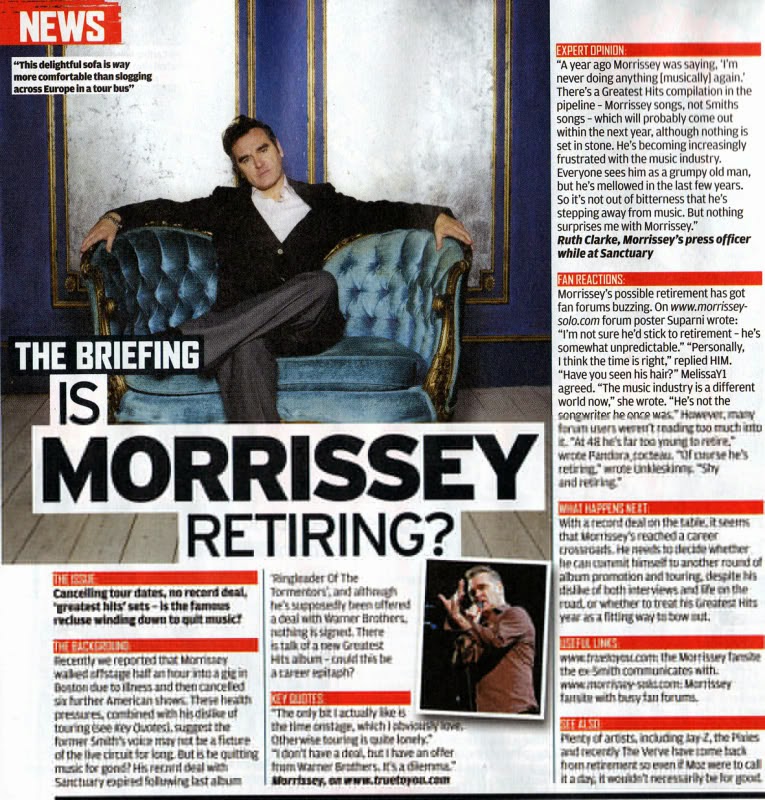NME
New Music Express is a
British weekly magazine that has been published since 1953. It is largely
associated with the rock, indie and alternative music genres. It was originally
a music newspaper, until it moved into a magazine format in the 1980s, changing
from newsprint in 1998. It was one of the first magazines to introduce a
singles chart and during the 1970s it was the bestselling British music
newspaper. An online version of NME was launched in 1996, and with over 7
million users on it per month it is the world’s biggest standalone music
website. According to http://www.nrs.co.uk/latest-results/nrs-print-results/general-magazines-nrsprintresults/ over 198,000 people purchase NME regularly. The
magazine obviously has the primary audience as Indie music fans and a secondary
audience of teenagers, judging by the grungy, informal image the magazine
conveys
NME magazines usually
feature a house style of white and red. This shows brand identity as the
audience can tell what the magazine they are after just by colour scheme
alone. Direct mode of address is used on
most of the magazine covers, as a featured band/band member on the coverlines
is usually looking at the audience. The masthead is located in the top left
corner of magazine suggesting unimportance; this could reflect how NME
specialises in the indie scene which is not typically well known. Most pages feature
an extract from an interview with the featured band. This attracts an audience
as we are interested in gossip and other people’s lives and implies what
content is in the magazine. Also importance to note is that the typography on
the band’s names are larger than the title of the magazine itself – suggesting
that the band is more important than the magazine. This implies that NME uses
the bands to attract a wide audience as possible. Those who are, for example,
MUSE fans are more likely to buy a NME magazine featuring MUSE on the front
cover than one with the “Black Keys” on it. On most of the magazine covers,
above the masthead are names of other bands, again implying content and
attracting a potential audience.
The contents pages also
share a similar colour scheme, and each use a similar layout. The page has a band
index in the left column, allowing for easy navigation of the contents within
the magazine. There is usually an image located in the middle of the page with
a short article below it, linking it to the text. The magazine has a
subscription form at the middle-bottom of it, immediately giving the audience
the option to subscribe. On the right are the contents itself, separated into
columns depending on whether they are reviews, features etc.
The
typography of the headlines are bold and highlighted, this makes it so the
audience’s attention is brought directly towards it. The highlights are
normally coloured red to reflect the colour scheme NME magazine has. The colour
used contrast with the main image, this way the audience’s attention is brought
to both the image and article. Text is usually placed at either side of the
magazine, with the image on the other, this makes the article easier to read
and navigate. The image usually re-enforces the headline of the article. The
image in the headline “The Teenagers” connotates the messy, carefree,
rebellious stereotype that young adults have. Another example would be “Is
Morrissey Retiring?” the image shows Morrissey on a comfy chair relaxed.
Similar
magazines that focus on the indie music scene are Q and INDIE, however NME is
the more popular option and focuses more on the rock sub-genre, leading to a
small rivalry with rock magazines such as Kerrang. The Rolling Stones magazine
also has some competition with NME as they are both popular music magazines.
NME has been featured on News sites such as
the guardian (http://www.theguardian.com/media) with articles as recent as the 7th
October 2014, showing how the magazine is still relevant today. However, one
article has mentioned that viewing figures of the magazine have been declining.
This could be however due to the fact the convergent nature of media has made
magazine articles feature more prominently on the internet. The magazine has recently
tried to appeal to a larger female audience and focus on more mainstream
artists in order to get a wider aduidence
One
of the most controversial writers in NME was Steve Wells, (http://www.theguardian.com/media/organgrinder/2009/jun/25/nme-writer-steven-wells-tribute-james-brown) who reportedly “Had little interest in music”.
Steve wrote articles featuring new bands that he had only recently discovered,
but his clever writing and sense of humour made him popular with readers and co-workers alike











No comments:
Post a Comment